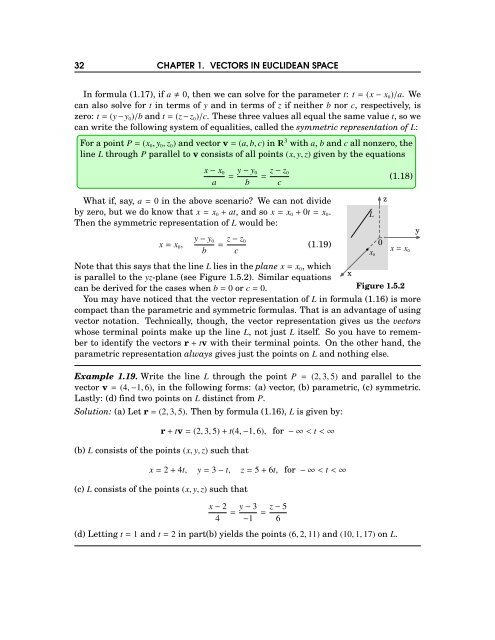Michael Corral: Vector Calculus
Michael Corral: Vector Calculus
Michael Corral: Vector Calculus
Create successful ePaper yourself
Turn your PDF publications into a flip-book with our unique Google optimized e-Paper software.
32 CHAPTER 1. VECTORS IN EUCLIDEAN SPACE<br />
In formula (1.17), if a0, then we can solve for the parameter t: t=(x− x 0 )/a. We<br />
can also solve for t in terms of y and in terms of z if neither b nor c, respectively, is<br />
zero: t=(y−y 0 )/b and t=(z−z 0 )/c. These three values all equal thesame valuet, so we<br />
can write the following system of equalities, called the symmetric representation of L:<br />
For a point P=(x 0 ,y 0 ,z 0 ) and vector v=(a,b,c) in 3 with a, b and c all nonzero, the<br />
line L through P parallel to v consists of all points (x,y,z) given by the equations<br />
x− x 0<br />
a<br />
= y−y 0<br />
b<br />
= z−z 0<br />
c<br />
(1.18)<br />
What if, say, a=0 in the above scenario? We can not divide<br />
by zero, but we do know that x= x 0 +at, and so x= x 0 +0t=x 0 .<br />
Then the symmetric representation of L would be:<br />
x= x 0 ,<br />
y−y 0<br />
b<br />
= z−z 0<br />
c<br />
(1.19)<br />
L<br />
x 0<br />
z<br />
0 x= x0<br />
Note that this says that the line L lies in the plane x= x 0 , which<br />
x<br />
is parallel to the yz-plane (see Figure 1.5.2). Similar equations<br />
can be derived for the cases when b=0or c=0.<br />
Figure 1.5.2<br />
You may have noticed that the vector representation of L in formula (1.16) is more<br />
compact than the parametric and symmetric formulas. That is an advantage of using<br />
vector notation. Technically, though, the vector representation gives us the vectors<br />
whose terminal points make up the line L, not just L itself. So you have to remember<br />
to identify the vectors r+tv with their terminal points. On the other hand, the<br />
parametric representation always gives just the points on L and nothing else.<br />
Example 1.19. Write the line L through the point P = (2,3,5) and parallel to the<br />
vector v=(4,−1,6), in the following forms: (a) vector, (b) parametric, (c) symmetric.<br />
Lastly: (d) find two points on L distinct from P.<br />
Solution: (a) Let r=(2,3,5). Then by formula (1.16), L is given by:<br />
r+tv=(2,3,5)+t(4,−1,6), for−∞








